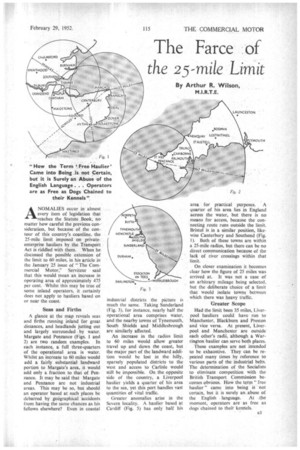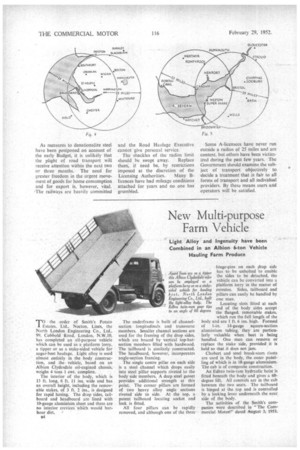The Farce of
Page 37

Page 38

If you've noticed an error in this article please click here to report it so we can fix it.
\ the 25-mi1e Limit By Arthur R. Wilson, M.I.R.T.E.
ANOMALIES occur in almost• every item of legislation that . reaches the Statute Book, no matter how careful the previous con-sideration, but because of the contour of this country's coastline, the 25-mile limit imposed on private enterprise hauliers by the Transport Act is riddled with them. When he discussed the possible extension of the limit to 60 miles, in his article in the January 25 issue of "The Commercial Motor," Serviteur said that this would mean an increase in operating area of approximately 475
, per cent. Whilst this may be true of some inland operators, it certainly does not apply to hauliers based on or near the coast.
Seas and Firths
A glance at the map reveals seas and firths running inland for great distances, and headlands jutting out and largely, surrounded by water. Margate and Penzance (Figs. I and 2) are two random examples. In each instance, a full three-quarters of the operational area is water. Whilst an increase to 60 miles would add a fairly substantial landward portion to Margate's area, it would add only a fraction to that of Penzance. It may be said that Margate and Penzance are not industrial areas. This may be so, but should an operator based at such places be debarred by geographical accidents from having the same chances as his fellows elsewhere? Even in coastal industrial districts the picture is much the same. Taking Sunderland (Fig. 3), for instance, nearly half the operational area comprises water, and the nearby towns of Tynernouth, South Shields and Middlesbrough are similarly affected.
An increase in the radius limit to 60 miles would allow greater travel up and down the coast, but the major part of the landward addition would be lost in the hilly, sparsely populated districts to the West and access to Carlisle would still be impossible. On the opposite side of the country, a Liverpool haulier yields a quarter of his area to the sea, yet this port handles vast quantities of vital traffic.
Greater anomalies arise in the Severn locality. A haulier based at Cardiff (Fig. 5) has only half his area for practical purposes. A quarter of his area lies in England across the water, but there is no means for access, because the connecting route runs outside the limit. Bristol is in a similar position, likewise Canterbury and Southend (Fig. 1). Both of these towns are within a 25-mile radius, but there can be no direct communication because of the lack of river crossings within that
On closer examination it becomes clear how the figure of 25 miles was arrived at. It was not a case of an arbitrary mileage being selected, but the deliberate choice of a 'limit that would isolate towns• between which there was heavy traffic.
Greater Scope
Had the limit been 35 miles, Liverpool hauliers could have run to Manchester, Blackburn and Preston and vice versa. At present, Liverpool and Manchester are outside each other's radii, although a Warrington haulier can serve both places.
These examples are not intended to be exhaustive. They can be repeated many times by reference to various parts of the industrial belts. The determination of the Socialists to eliminate competition with the British Transport Commission becomes obvious. How the term "free haulier " came into being is not certain, but it is surely an, abuse of the English language. At the moment, operators are as free as dogs chained to their kennels. As measures to denationalize steel have been postponed on account of the early Budget, it is unlikely that the plight of road transport will receive attention within the next two or three months. The need for greater freedom in the urgent movement of goods for home consumption and for export is, however, vital. The railways are heavily committed and the Road Haulage Executive cannot give personal service..
The shackles of the radius limit should be swept away. Replace them, if need be, by restrictions imposed at the discretion of the
Licensing Authorities. Many Blicences have had mileage conditions attached for years and no one has grum bl ed.
Some A-licensees have never run outside a radius of 25 miles and are content, but others have been victimized during the past few years. The Government should examine the subject of transport objectively to decide a treatment that is fair to all forms of transport and all individual providers. By these means users and operators will be satisfied.




















































































